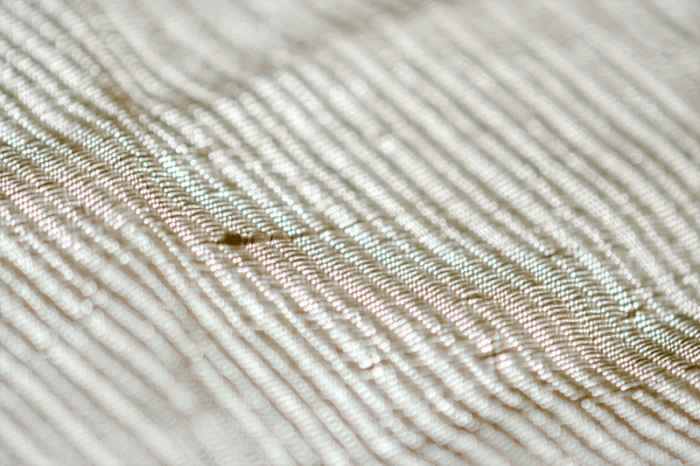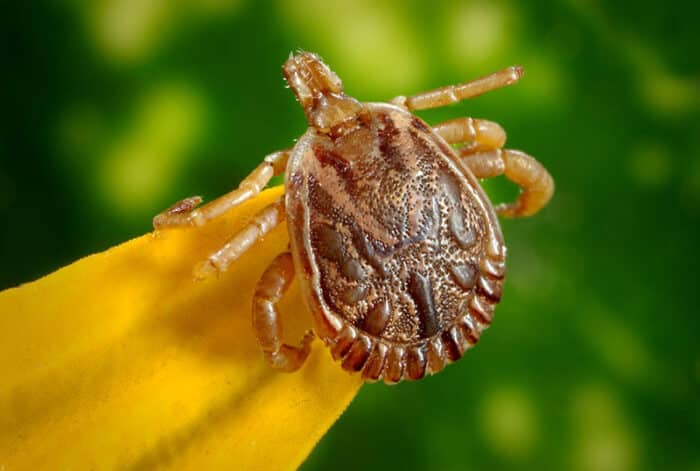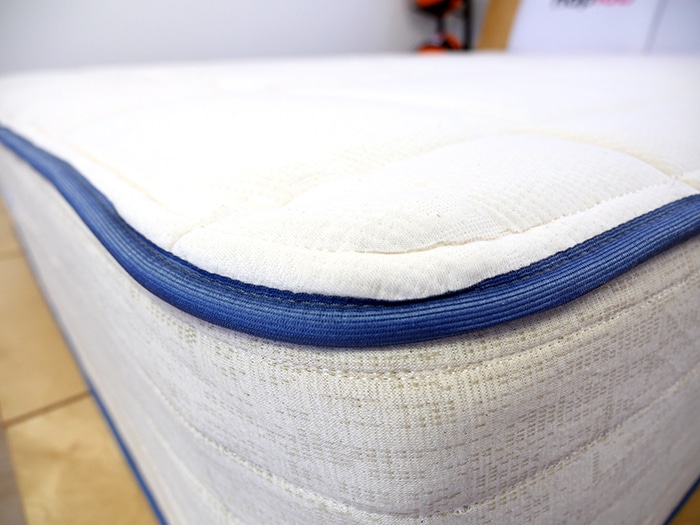When you go to sleep, most people look forward to sweet dreams and solitude, but that’s not always the case for everyone (or everything) in the room.
Bed bugs can be irritating visitors that hide in plain sight and feast on you when you’re sound asleep.
In This Guide
Signs of Bed Bugs | Where Bed Bugs Hide | Where Bed Bugs Bite | How to Get Rid of Bed Bugs

This guide will explain the red flag signs of bed bugs, tell you where they hide, when they bite, and how to get rid of them. Let’s get started.
Signs of Bed Bugs
Although bed bugs are quite small, they do leave behind a few sure signs that they’ve been there. Here are five of the most common signs of bed bugs to watch for.

If you see any of these signs, or if you see live bugs crawling around, skip ahead to the section below, How to Get Rid of Bed Bugs.
#1. Strange odors
Ever walk into a hotel room (or any bedroom actually) and get a whiff of a strange odor? The smell of a bed bug has often been described as a musty, sweet smell, similar to berries.

This odor is not usually found in a bedroom, so if you detect this scent, it’s time to carefully check your bed, bedding, pillows, and surrounding textiles for the presence of bed bugs.
#2. Unexplained bites
Going to bed without any noticeable bites and waking up to red, swollen circular bites is one of the most common signs of bed bugs. Bites can occur anywhere on your body but are most common on the hands, neck, face, shoulders, legs, and arms.
These pesky critters usually are clustered in groups so you may see multiple bite marks together in one area.
#3. Dark spots
When bed bugs bite, the goal is to extract blood. As they do this through small, piercing bites, small drops of blood may be found on or around the begging as well.
Bug droppings or shell casing can also be crushed into the bedding. As the spots age, they can get darker and become more noticeable.

At first, you may brush these spots off as some dirt or other simple stain on the bedding, but over time these spots may be repetitive or even increase in number.
If unexplained dark spots begin to appear on your bed, consider the possibility of a bed bug infestation.
#4. Bug shell parts
I touched on this a little when discussing dark spots, but be on the lookout for any remnants of crushed shells, casings, droppings, legs, etc. Things can get a little tight for bed bugs.

As their life cycle completes, you may find crusty, little bed bug remains in or around your bed.
#5. Bed bug eggs
The goal of bed bugs as with most other animals is to grow, feed, and lay more eggs. But eggs in the bed can be a big problem. Let’s do some bed bug math.

After feeding once, a female bed bug can produce between 1 and 7 eggs for a span of 10 days, resulting in as many as 70 eggs.
Once laid, eggs hatch in 6-10 days and by 10 weeks the bugs have reached full maturity. Rinse and repeat.
One single bed bug can lay up to 200 eggs in her lifetime and beg bugs rarely work alone. Within a matter of a few weeks, you could indeed have thousands of bed bugs cozying up next to you.
What do beg bug eggs look like?
Bed bug eggs are only about the size of a pinhead and pearly-white in color. If the egg is more than 5 days old, there will be a visible eye spot in the middle. They are usually laid in a cluster of between 7-70 eggs at once.
Where do bed bugs hide?
So if bed bugs are only in your bed, why can’t you see them?
Chances are you aren’t looking in the right places. Bed bugs are very tiny and they have a flattened body that allows them to easily fit in very narrow spaces (think the thickness of a credit card).

In the bedroom, they like to hide in sheets, mattress protectors, pillowcases, shams, etc. You may also want to check your headboard, boxspring, or bed frame.
Check the seams or areas where the fabric bunches up (like the corners or head / foot of the bed where bedding is often tucked in.

In these areas, bed bugs can congregate and fly under the radar, while still maintaining close proximity to you for feeding times.
Where do bed bugs bite?
Bed bugs are more often to bite people at night, but it’s not because they are nocturnal. Bed bugs are opportunists and the reality is that they have a larger window of time to feed in the middle of the night when people are asleep.

If you work a night job and sleep during the day, bed bugs could easily adjust their schedule to accommodate, so don’t consider yourself an exception to the rule in these cases.
What happens when a bed bug bites you?
When bed bugs bite, they do so quietly and oftentimes totally undetected. Their source of food is blood, which they can extract from your body by piercing the skin and withdrawing it using their elongated beak.
A bed bug feeding session lasts anywhere from 3-10 minutes. Once it’s done, they will be engorged like a fat tick and sneak off to go digest under your covers.
Even if they have to skip a few meals, bed bugs can survive up to a year without feeding, depending on temperatures.
How to Get Rid of Bed Bugs
Getting rid of bed bugs can be difficult, but certainly not impossible. These pests are small, sneaky, and can be tricky to detect. The best way to get rid of bed bugs 100% is to call your local pest company.
If you spot an infestation in your mattress, it’s possible that the bugs have spread into the pillow, headboard, bed frame, clothes, towels, carpet, etc. And at the rate that bed bugs can reproduce, it’s challenging to kill off a whole colony without some professional help.
That being said, there are some things you can do. For immediate action, can also try the tips below.
How to Kill Bed Bugs by Yourself
- Vacuum up live bed bugs. The crevice tool is great for this and really helps to get in small cracks and crevices where they often hide.
- Wash all bedding in hot water. Hot water is more effective at killing bed bugs compared to cold water since it’s actually the heat that kills them, not the water.
- Tumble dry on high heat. Again, it’s the heat that kills bed bugs. For items like quilts, sheets, and pillows, tumble dry on as high of heat that the manufacturer recommends. Heat kills bed bugs.
- Freeze the infested items. Freezing items can also be an effective way to kill bed bugs. For this method to work, the freezer needs to be set to 0° F and the item must be left in the freezer for 4 days.
- Place items outside. For items that cannot be washed or frozen, you can sometimes place them outside to kill bed bugs, depending on the temperature. If left outside for 24 hours, temperatures lower than 32° F or higher than 95° F could effectively kill bed bugs.
FAQs
Look for the 5 signs of bed bug infestations outlined above—odors, bites, dark spots on bedding, shell casings, or eggs. These are all strong signs that you have an active and ongoing bed bug problem.
Bites can occur anywhere on your body but are most common on the hands, neck, face, shoulders, legs, and arms.
Yes. Pillows provide a great potential habitat for bed bugs, or even worse, bed bug eggs. To avoid bed bugs in your pillow, be sure to examine and wash your pillows regularly. For extra protection, you could also consider adding a bug-proof pillow protector.
Bed bugs can live for up to a year, depending on temperatures.
A female bed bug can lay up to 200 eggs in her lifetime. After feeding, she will lay between 1-7 eggs over a span of 10 days, resulting in up to 70 eggs at a time.
Yes. If the water isn’t hot enough, bed bugs can survive a spin around the washing machine. Hot water kills bed bugs best.
Bed bugs will typically hatch in 6-10 days, depending on temperatures and other conditions.
No. The temperature of an electric heating blanket is not hot enough to effectively kill bed bugs. If anything, it can sometimes encourage bed bugs since it’s warm and a good breeding ground.
Sometimes. This can be an effective way to kill bed bugs, but the freezer must be set at 0° F. To try this method, put the infested item in a sealed plastic bag and drop it in the freezer for at least 4 days.
Adult bed bugs die at 119° F, and bed bug eggs die at 125° F.


